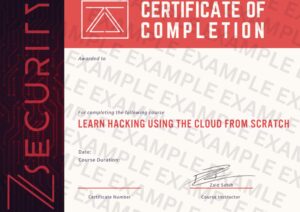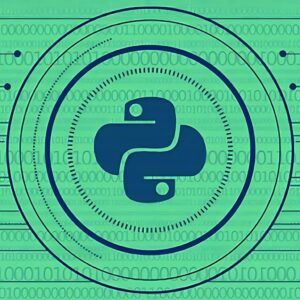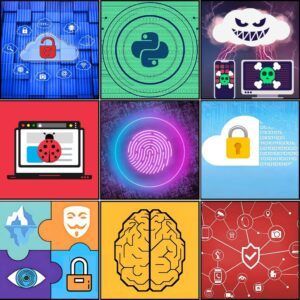$99.99
Learn Python & Ethical Hacking From Scratch Course
Become a Hacker

Learn how to write your own hacking programs with python
This comprehensive Python Programming and Ethical Hacking course is designed for complete beginners, taking you from scratch to a high intermediate level.
By the end, you’ll be able to write Python programs to hack computer systems like black-hat hackers while also gaining the skills to develop any type of program, even outside of hacking. The course is highly practical, starting with the basics of ethical hacking and Python programming before diving into hands-on coding. Each section focuses on hacking a specific system, teaching you how it works, its weaknesses, and how to exploit them with custom Python scripts. As you write these programs, you’ll learn Python from scratch, covering key concepts step by step.
By the end, you’ll have built multiple hacking tools—such as backdoors, keyloggers, and credential harvesters—while developing a strong understanding of computer systems, problem modeling, algorithm design, and Python implementation.
$99.99
$99.99
Learn how to write your own hacking programs with python
This comprehensive Python Programming and Ethical Hacking course is designed for complete beginners, taking you from scratch to a high intermediate level.
By the end, you’ll be able to write Python programs to hack computer systems like black-hat hackers while also gaining the skills to develop any type of program, even outside of hacking. The course is highly practical, starting with the basics of ethical hacking and Python programming before diving into hands-on coding. Each section focuses on hacking a specific system, teaching you how it works, its weaknesses, and how to exploit them with custom Python scripts. As you write these programs, you’ll learn Python from scratch, covering key concepts step by step.
By the end, you’ll have built multiple hacking tools—such as backdoors, keyloggers, and credential harvesters—while developing a strong understanding of computer systems, problem modeling, algorithm design, and Python implementation.
$99.99
Python Programming
Ethical Hacking
Create Hacking Tools
Python 2 & 3
- Course Length: 24 hours
- Skill Level: Beginner – Intermediate
- Course type: Pre-Recorded Lessons
What is included?
- 180+ Videos and 16 downloadable resources
- Learn 2 topics at the same time – Python programming & Ethical Hacking
- Lifelong access to the course materials
- Full time support from our expert team
- Verifiable zSecurity certification of completion (Applicable to CPA)
- Free 1 Month zSecurity Trial VIP membership↳ Live Mentoring and Q&A sessions
↳ Access to the zSecurity discord with like-minded hacking community members
↳ Daily Updates, latest tutorials and news from the hacking world
↳ Daily resources like CTFs, Bug Bounties, Onion services, etc
↳ Discounts and offers on other zSecurity products and services
5 REASONS TO STUDY Python & Ethical Hacking
- Understand a Hacker’s Mindset: Learn hidden techniques used by attackers.
- Build Your Own Tools: Develop custom security tools for penetration testing and vulnerability analysis.
- Expand Career Opportunities: Ethical hackers with Python expertise are in high demand worldwide.
- Master Automation: Use Python to automate ethical hacking tasks and security assessments.
- Personal Development: Enhance critical thinking, problem-solving, and cybersecurity skills.
Why zSecurity
- Lifelong access to the courses.
- Study at your own pace with our pre-recorded lessons.
- Trusted by over 707,998 students.
- Lectures are updated as the industry changes.
- Access to our team of experts.
- Ethical Hacking and Cybersecurity Community.
- Learn all elements of Ethical Hacking and Cybersecurity.
- Beginner friendly and welcoming.
Curriculum
- Introduction 13
- TeaserLecture1.107 min
- Course IntroductionLecture1.207 min
- Introduction to Python Programming & Ethical HackingLecture1.306 min
- Initial OverviewLecture1.406 min
- Initial PreparationLecture1.509 min
- Installing Kali Linux as a VM on WindowsLecture1.609 min
- Installing Kali Linux as a VM on Apple Mac OS (Intel & Silicon Chips)Lecture1.709 min
- Installing Kali Linux as a VM on LinuxLecture1.811 min
- Basic Overview of Kali LinuxLecture1.905 min
- The Terminal & Linux CommandsLecture1.1010 min
- More Powerful Linux Terminals with AI FeaturesLecture1.1105 min
- Python 2 VS Python 3 & Writing Our First ProgramLecture1.1209 min
- Installing & Using a Python IDELecture1.1310 min
- Writing a MAC Address Changer - Python Basics 13
- What is MAC Address & How To Change itLecture2.108 min
- Using Python Modules & Executing System CommandsLecture2.209 min
- Implementing a Very Basic MAC ChangerLecture2.305 min
- Variables & StringsLecture2.410 min
- Using Variables in MAC ChangerLecture2.505 min
- Getting Input From The UserLecture2.606 min
- Handling User InputLecture2.710 min
- Handling Command-line ArgumentsLecture2.810 min
- Initialising Variables Based on Command-line ArgumentsLecture2.908 min
- Python FunctionsLecture2.1010 min
- Returning Values From FunctionsLecture2.1107 min
- Decision Making in PythonLecture2.1207 min
- Using Conditional Statements in MAC ChangerLecture2.1309 min
- MAC Changer - Algorithm Design 7
- Introduction to AlgorithmsLecture3.103 min
- Reading Output Returned By System CommandsLecture3.206 min
- Introduction to Regular Expressions (Regex)Lecture3.308 min
- Extracting a Substring Using RegexLecture3.407 min
- Refactoring & HousekeepingLecture3.511 min
- Implementing The Validation AlgorithmLecture3.606 min
- Python 3 CompatibilityLecture3.706 min
- Programming a Network Scanner 17
- Introduction & TeaserLecture4.110 min
- Installing Windows as a Virtual MachineLecture4.206 min
- Installing Windows as a Virtual Machine on Apple Silicon ComputersLecture4.305 min
- Introduction to ARPLecture4.410 min
- Designing an Algorithm To Discover Clients Connected To The Same NetworkLecture4.504 min
- Using Scapy To Create an ARP RequestLecture4.607 min
- Combining Frames To Broadcast PacketsLecture4.710 min
- Sending & Receiving PacketsLecture4.807 min
- Introduction Lists in PythonLecture4.908 min
- Iterating Over Lists & Analysing PacketLecture4.1010 min
- Using Escape Characters To Enhance Program OutputLecture4.1106 min
- Introduction to Dictionaries in PythonLecture4.1210 min
- Improving the Program Using a List of DictionariesLecture4.1309 min
- Iterating Over Nested Data StructuresLecture4.1407 min
- Assignment 1: Get IP Range Using Command Line ArgumentsLecture4.15
- Assignment 1 (solution): Get IP Range Using Command Line Arguments – solutionLecture4.16
- Testing The Network Scanner With Python 3Lecture4.1705 min
- Writing an ARP Spoofer 13
- What is ARP Spoofing?Lecture5.106 min
- Intercepting Data in a Network Using arpspoofLecture5.205 min
- Creating an ARP ResponseLecture5.307 min
- Sending ARP ResponsesLecture5.406 min
- Extracting MAC Address From ResponsesLecture5.507 min
- Introduction to Loops in PythonLecture5.609 min
- More on Loops & CountersLecture5.708 min
- Dynamic PrintingLecture5.807 min
- Exception Handling in PythonLecture5.905 min
- Implementing a Restore FunctionLecture5.1012 min
- Restoring ARP Tables on ExceptionLecture5.1106 min
- Assignment 2: Fix Dynamic PrintingLecture5.12
- Assignment 2 (solution): Fix Dynamic PrintingLecture5.13
- Writing a Packet Sniffer 8
- Introduction & TeaserLecture6.105 min
- Sniffing Packets Using ScapyLecture6.207 min
- Extracting data From a Specific LayerLecture6.307 min
- Analysing Sniffed Packets & Extracting Fields From LayersLecture6.412 min
- Analysing Fields & Extracting PasswordsLecture6.511 min
- Extracting URLsLecture6.608 min
- Capturing Passwords From Any Computer Connected to the Same NetworkLecture6.708 min
- Strings & Bytes in Python 3Lecture6.807 min
- Writing a DNS Spoofer 9
- Intercepting Packets – Creating a ProxyLecture7.113 min
- Converting Packets to Scapy PacketsLecture7.209 min
- Introduction to DNS SpoofingLecture7.307 min
- Filtering DNS ResponsesLecture7.406 min
- Analysing & Creating a Custom DNS ResponseLecture7.508 min
- Modifying Packets On The FlyLecture7.608 min
- Redirecting DNS ResponsesLecture7.706 min
- Assignment 3: Conversion Between Strings & BytesLecture7.8
- Assignment 3 (solution): Conversion Between Strings & BytesLecture7.9
- Writing a File Interceptor 8
- Introduction & TeaserLecture8.104 min
- Filtering Traffic Based on the Port UsedLecture8.209 min
- Analysing HTTP RequestsLecture8.306 min
- Intercepting HTTP RequestsLecture8.410 min
- Modifying HTTP Responses on The FlyLecture8.511 min
- Intercepting & Replacing Downloads on The NetworkLecture8.610 min
- Assignment 4: Testing The File Interceptor With Python 3Lecture8.7
- Assignment 4 (solution): Testing The File Interceptor With Python 3Lecture8.8
- Writing a Code Injector 15
- Introduction & TeaserLecture9.101 min
- Analysing HTTP ResponsesLecture9.207 min
- Replacing a Substring Using RegexLecture9.307 min
- Decoding HTTP ResponsesLecture9.410 min
- Modifying HTTP Responses & Injecting Javascript Code in HTML PagesLecture9.509 min
- Refactoring & HousekeepingLecture9.608 min
- Debugging Issues in PythonLecture9.706 min
- Using Groups & None-capturing RegexLecture9.809 min
- Recalculating Content LengthLecture9.912 min
- Assignment 5: Test The Code Injector With Python 3Lecture9.10
- Assignment 5 (solution): Test The Code Injector With Python 3Lecture9.1109 min
- BeEF Overview & Basic Hook MethodLecture9.1207 min
- Hooking Computers Using code_injectorLecture9.1306 min
- Basic BeEF CommandsLecture9.1404 min
- Delivering Malware Using BeEFLecture9.1506 min
- Bypassing HTTPS 4
- How to Bypass HTTPSLecture10.111 min
- Bypassing HTTPS & Sniffing Login CredentialsLecture10.206 min
- Replacing Downloads on HTTPS PagesLecture10.308 min
- Injecting Code in HTTPS PagesLecture10.408 min
- Writing an ARP Spoof Detector 3
- Running Python Programs on WindowsLecture11.110 min
- Capturing & Analysing ARP ResponsesLecture11.207 min
- Detecting ARP Spoofing Attacks Using PythonLecture11.308 min
- Writing Malware 10
- Introduction & TeaserLecture12.102 min
- Execute System Command PayloadLecture12.210 min
- Sending Emails Using PythonLecture12.313 min
- Filtering Command Output Using RegexLecture12.410 min
- Stealing WiFi Passwords Saved on a ComputerLecture12.510 min
- Downloading Files Using PythonLecture12.608 min
- Writing Files on DiskLecture12.711 min
- Password Recovery BasicsLecture12.808 min
- Stealing Saved Passwords From Remote ComputersLecture12.908 min
- Interacting With The File System Using PythonLecture12.1010 min
- Writing Malware - Keylogger 8
- Introduction & TeaserLecture13.104 min
- Writing a Basic Local Keylogger Using PythonLecture13.210 min
- Introduction to Global VariablesLecture13.308 min
- Logging Special KeysLecture13.407 min
- Introduction to Threading & Recursion in PythonLecture13.511 min
- Introduction Object Oriented ProgrammingLecture13.615 min
- Constructor Methods & Instance VariablesLecture13.708 min
- Logging Key-strikes and Reporting Them By EmailLecture13.812 min
- Writing Malware - Backdoors 21
- Introduction & TeaserLecture14.106 min
- Client – Server Communication & Connection TypesLecture14.208 min
- Connecting Two Remote Computers Using SocketsLecture14.310 min
- Sending & Receiving Data Over TCPLecture14.405 min
- Executing System Commands RemotelyLecture14.510 min
- Implementing a ServerLecture14.609 min
- Implementing Skeleton For Server – Client CommunicationLecture14.707 min
- Refactoring – Creating a Listener ClassLecture14.808 min
- Refactoring – Creating a Backdoor ClassLecture14.906 min
- Serialisation – TheoryLecture14.1011 min
- Serialisation – Implementing Reliable Methods to Send & Receive Data Over TCPLecture14.1108 min
- Serialisation – Reliably Sending & Receiving DataLecture14.1206 min
- Sending Commands as List & Implementing Exit CommandLecture14.1308 min
- Interacting With the File System – Implementing “cd” CommandLecture14.1409 min
- Reading Files Using PythonLecture14.1508 min
- Writing Files Using PythonLecture14.1607 min
- Downloading Files From Hacked ComputerLecture14.1708 min
- Implementing Upload Functionality in ListenerLecture14.1808 min
- Implementing Upload Functionality in BackdoorLecture14.1906 min
- Handling Unknown ExceptionsLecture14.2010 min
- Using the Backdoor to Hack Windows, Linux & OS XLecture14.2113 min
- Writing Malware - Packaging 15
- Introduction & TeaserLecture15.103 min
- Converting Python Programs To Windows Binary ExecutablesLecture15.207 min
- Running Executables SilentlyLecture15.307 min
- Installing Windows Pyinstaller on LinuxLecture15.408 min
- Packaging Programs For Windows From LinuxLecture15.509 min
- Introduction to PersistenceLecture15.608 min
- Running Programs on StartupLecture15.715 min
- Creating a Basic Trojan Using Download & Execute PayloadLecture15.811 min
- Creating a Trojan By Embedding Files In Program CodeLecture15.909 min
- Bypassing Anti-Virus Programs – TheoryLecture15.1005 min
- Bypassing Anti-Virus Programs – PracticalLecture15.1109 min
- Adding an Icon to Generated ExecutablesLecture15.1205 min
- Spoofing File ExtensionLecture15.1310 min
- Converting Python Programs To OS X ExecutablesLecture15.1409 min
- Converting Python Programs to Linux ExecutablesLecture15.1507 min
- Website / Web Application Hacking 3
- Introduction & TeaserLecture16.107 min
- What is a WebsiteLecture16.204 min
- How to Hack a WebsiteLecture16.306 min
- Website Hacking - Writing a Crawler 9
- Sending GET Requests To Web ServersLecture17.110 min
- Discovering Website Subdomains Using PythonLecture17.212 min
- Discovering Hidden Paths in WebsitesLecture17.311 min
- Reading Response ContentLecture17.406 min
- Extracting Useful Data From ResponseLecture17.507 min
- Filtering ResultsLecture17.607 min
- Extracting Unique Links & Storing Them In a ListLecture17.707 min
- Recursively Discovering All Paths On a Target WebsiteLecture17.810 min
- Testing The Crawler With Python 3Lecture17.907 min
- Writing a Program To Guess Login Information 4
- Sending Post Requests to WebsitesLecture18.112 min
- Guessing Login Information on Login PagesLecture18.209 min
- Assignment 6: Test The Program With Python 3Lecture18.3
- Assignment 6 (solution): Test The Program With Python 3Lecture18.4
- Writing a Vulnerability Scanner 17
- Introduction & TeaserLecture19.103 min
- HTTP Requests – POST VS GETLecture19.207 min
- Parsing HTML Code Using PythonLecture19.308 min
- Extracting HTML AttributesLecture19.411 min
- Posting FormsLecture19.510 min
- Building Basic Structure For Vulnerability ScannerLecture19.611 min
- Using Default ParametersLecture19.705 min
- Sending Requests in a SessionLecture19.809 min
- Extracting & Submitting Forms AutomaticallyLecture19.910 min
- Implementing a Method To Run The ScannerLecture19.1006 min
- Discovering XSS VulnerabilitiesLecture19.1109 min
- Exploiting XSS VulnerabilitiesLecture19.1205 min
- Implementing Code To Discover XSS in FormsLecture19.1308 min
- Implementing Code To Discover XSS in ParametersLecture19.1408 min
- Automatically Discovering Vulnerabilities Using the Vulnerability ScannerLecture19.1509 min
- Assignment 7: Test The Vulnerability Scanner With Python 3Lecture19.16
- Assignment 7 (solution): Test The Vulnerability Scanner With Python 3Lecture19.1705 min
- Bonus Section 1
- Bonus Lecture – What’s Next??Lecture20.1
What you will learn
- Write over 20 hacking and security programs
- No programming, hacking or Linux knowledge required
- Write programs in Python 2 and 3
- Write cross platform programs that work on Windows, Apple Mac OS & Linux
- Have a deep understanding on how computer systems work
- Install hacking lab & needed software (on Windows, Apple Mac OS and Linux)
- Start from 0 up to a high-intermediate level
- Learn by example, by writing exciting programs
- Model problems, design solutions & implement them using Python
- Have a strong base & use the skills learned to write any program even if its not related to hacking
- Understand what is Hacking, what is Programming, and why are they related
- Design a testing lab to practice hacking & programming safely
- Interact & use the Linux terminal
- Understand what MAC address is & how to change it
- Write a python program to change MAC address
- Use Python modules and libraries
- Understand Object Oriented Programming
- Write object oriented programs
- Model & design extendable programs
- Write a program to discover devices connected to the same network
- Read, analyse & manipulate network packets
- Understand & interact with different network layers such as ARP, DNS, HTTP ....etc
- Write a program to redirect the flow of packets in a network (ARP spoofer)
- Write a packet sniffer to filter interesting data such as usernames and passwords
- Write a program to redirect DNS requests (DNS Spoofer)
- Intercept and modify network packets on the fly
- Write a program to replace downloads requested by any computer on the network
- Analyse & modify HTTP requests and responses
- Inject code in HTML pages loaded by computers on the same network
- Downgrade HTTPS to HTTP
- Write a program to detect ARP Spoofing attacks
- Write payloads to download a file, execute command, download & execute, download execute & report .....etc
- Use sockets to send data over TCP
- Write client-server programs
- Write a backdoor that works on Windows, Apple Mac OS and Linux
- Implement features in the backdoor such as file system access, upload and download files and persistence
- Write a remote keylogger that can register all keystrikes and send them by Email
- Interact with files using python (read, write & modify)
- Convert python programs to binary executables that work on Windows, OS X and Linux
- Convert malware to torjans that work and function like other file types like an image or a PDF
- Bypass Anti-Virus Programs
- Understand how websites work, the technologies used and how to test them for weaknesses
- Send requests towebsites and analyse responses
- Write a program that can discover hidden paths in websites
- Write a program that can map websites and discover all links, subdomains, files and directories
- Extract and submit forms using python
- Run dictionary attacks and guess login information on login pages
- Analyse HTML using Python
- Interact with websites using Python
- Write a program that can discover vulnerabilities in websites
Certification
After you finish the course, you will receive a Digital Certification that has a verifiable code of completion. The Certification includes hours studied on the course and does count towards your CPA hours. This Certification is also signed by Zaid, CEO of zSecurity.
Requirements
- Basic IT Skills.
- No Linux, programming or hacking knowledge required.
- Computer with a minimum of 4GB ram/memory.
- Operating System: Windows / Apple Mac OS / Linux.
Who Is This For?
- Beginners in cybersecurity
- Aspiring ethical hackers
- Programming novices
- IT professionals looking to expand skills
- Students interested in practical cybersecurity applications
- Software developers exploring cybersecurity
- Anyone curious about ethical hacking and Python programming
- Tech enthusiasts
Your Ethical Hacking Journey with zSecurity
1. Purchase our Python & Ethical Hacking Course
Choose the course that is most relevant to you! If you're a Beginner who wants to learn Ethical Hacking generally, we recommend "Learn Ethical Hacking from Scratch" as a good starting point.
2. Instant Access to your Course
Once you complete your purchase, you will receive a confirmation email. The course is accessible by logging into your account on zsecurity.org. You can find all the courses you have purchased in "My Account".
3. Learn about the Python & Ethical Hacking at your own pace
Your courses never expire so you will have life-long access to the course materials and lessons, this means you can study at your own pace and return to previous lecturers to revise a previous topic even after completing.
4. Receive your zSecurity Digital Certification with proof of completion
After completing all the lessons in your course, you will receive a Digital Certification that has a verifiable code of completion.




Meet Your Instructor: Zaid
> Ethical Hacker
> Computer Scientist
> CEO of zSecurity
MY APPROACH TO LEARNING
“I focus on teaching practical skills that are essential and actively utilized by professionals in the field every day. My courses are highly practical but they don’t neglect the theory; I start with ensuring that students have a solid understanding of the fundamentals and the target system that we are trying to hack. Then we start hacking straight away! I teach everything through hands-on real-life examples and labs. No dry boring lectures.”
Purchase Options
Get the course on its own or included as a bundle
Reviews
 Shafique Ahmed  I did Global C|EH but I found this course by Zaid Sabih is more useful and full of latest stuff. I really like this course and looking forward to do more course by Zaid Sabih.  Jash Merchant  The explanation is awesome , especially the notes and resources provided in between just makes everything easy to understand. Thanks a lot Sir Zaid.  Phil Lutkovsky  This guy is just the best at this... I am a course hoarder so I know what I am talking about. He may not cover ALL topics in the world, that would make this course 500 hours long, but the things he DOES cover he covers in great detail.  Hossain Md Zakir  Excellent course I have ever found online. Mr Zaid is very helpful and friendly Instructor. He made all the courses easy to understand for every level student. Thank you very much Mr Zaid for your best effort on online teaching. |
Get Professionally Certified in Ethical Hacking
There a range of professional certifications available, make sure you study hard!
Ethical Hacking Career Possibilities
There a range of professional certifications available, make sure you study hard!
Upgrade your Hacking Kit with Essential Tools
Budget Hacking Adapter

$24.99
Best Value Hacking Adapter

$34.99
BadUSB Silent Intrusion Kit Plus

$74.97
$69.97
Hacker
Starter Kit




